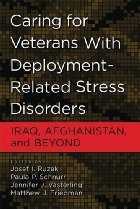Caring for Veterans with Deployment Related Stress Disorders: Iraq, Afghanistan and Beyond
According to recent studies, at least one-fourth of military personnel returning from duty in Afghanistan and Iraq have received a diagnosis of posttraumatic stress disorder (PTSD); approximately 10-15% of these veterans will experience significant symptoms. Whether the causes stem from a more complex environment in these post-9/11 war zones, or from more survivability because of improved body armor, better medical care, and more sophisticated diagnosis, the prevalence of PTSD and other war-related stress disorders among returning military personnel is on the rise.
Veterans of any war face major challenges reintegrating into civilian society, but these challenges become much more complex with an accompanying stress disorder. And the new demographic profile of today’s military–more female, more married, and more ethnically diverse–means that troops on and off the battlefield are more vulnerable to combat and noncombat stressors, the latter including sexual abuse. Suicide rates among these veterans are at an alarming high. The higher prevalence of these deployment-related stress disorders also has troubling ramifications among the parents, spouses, and children of these veterans.
Caring for Veterans With Deployment-Related Stress Disorders explores the myriad causes and consequences of these peculiar war-zone disorders, yet its emphasis is on prevention and treatment through better assessment, psychopharmacological and psychotherapeutic interventions (including couple/family therapy), and appropriate evidence-based treatments. The final part of this edited volume concludes with broad guidelines for minimizing current barriers to treatment for stress-disordered veterans and their families by shifting care to the local/community level of health care providers.
Contributors to Caring for Veterans With Deployment-Related Stress Disorders are leaders in the clinical and research communities devoted to studying and treating PTSD and other war-trauma stress disorders among military personnel. The editors of the volume are all top officials and researchers at the Veterans Administration’s National Center on PTSD.

